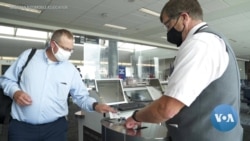The COVID-19 narrative in the United States a year ago was one of hospitalizations, shifting state-by-state regulations, and hoping and waiting for vaccines to emerge, as the country was on the upswing of a second surge of infections.
It would be a long wait, and a painful one, with millions more cases and hundreds of thousands of deaths to come.
The story of 2021, on the other hand, is about vaccinations and variants of the virus, two related and competing forces set to shape American life.
Dr. William Schaffner, a professor in the Division of Infectious Diseases at Vanderbilt University Medical Center, told VOA that while the United States has seen a substantial reduction in cases, progress has flattened out, and the delta variant is "now picking off unvaccinated people."
"A very telling statistic is that if you look at who's being hospitalized today, who are the people getting so sick with COVID that they need to come into the hospital, 90-plus percent of them are unvaccinated or partially vaccinated," Schaffner said. "In other words, the vaccines are keeping vaccinated people out of the hospital. They're doing their job. But there are so many unvaccinated people that the virus keeps finding them, making them sick and admitting them to the hospital, all of which is preventable."
Tale of two holidays
July 4, 2020, saw a relatively subdued celebration of the Independence Day holiday, with cities and towns canceling their annual fireworks celebrations and people opting to stay home instead of attending picnics and parties.
Roughly 500 people were dying each day in the United States. The country was a few days away from tallying its 3 millionth confirmed case of COVID-19.
To listen to President Donald Trump speak at a White House celebration that day, the situation was not that bad.
"We've made a lot of progress. Our strategy is moving along well," Trump said. "It goes out in one area and rears back its ugly face in another area. But we've learned a lot. We've learned how to put out the flame."
The surge found its peak a few weeks later, claiming 1,100 lives on an average day and infecting 68,000 more people. The president thanked frontline medical workers in attendance on the South Lawn of the White House and touted the government's shipments of ventilators to other nations in need.
Independence Day this year is shadowed by a grim past, with more than 600,000 dead in the U.S. — the most of any country — but a brighter present, with new cases at levels lower than those seen in the early days of the outbreak. Medical workers who scrambled last year to figure out how to combat a new and deadly disease now have extensive experience doing so.
"The major change is that we have vaccines, of course, but also we have a sense of how to treat patients with COVID-19," said Dr. Taison Bell, assistant professor of medicine in the divisions of infectious disease and pulmonary/critical care medicine at the University of Virginia. "I wouldn't say that we completely feel comfortable taking care of patients, because this still is a relatively new disease, but we still have a sense of what we should do."
The U.S. Food and Drug Administration has authorized three COVID-19 vaccines for emergency use — those made by Pfizer, Moderna and Johnson & Johnson — with everyone age 12 and older eligible to get the shots.
Those vaccines, the culmination of a U.S.-government-backed program that was only seven weeks old this time last year, have been a major focus of the administration of President Joe Biden, who pledged to get 100 million doses in arms during his first 100 days in office.
The Centers for Disease Control and Prevention achieved more than double that amount. The CDC now says the United States has administered 324 million doses, with about 154 million people, including 57% of adults, fully vaccinated against COVID-19.
Biden in recent months has pointed to July 4 as a milestone for the nation, and despite falling short of his aim to have 70% of adults receive one vaccination dose by Independence Day, he says the country is heading into what he calls a "summer of joy."
But while the White House is hosting what press secretary Jen Psaki calls "a party for frontline workers and men and women who served our country," administration and health officials have expressed unease about the number of people who remain unvaccinated.
"The truth is that deaths and hospitalizations are drastically down in places where people are getting vaccinated," Biden said in mid-June. "But unfortunately, cases and hospitalizations are not going down. So even while we're making incredible progress, it remains a serious and deadly threat."
Variant challenges
That threat has become even more deadly because of virus variants, including the delta variant that the CDC says spreads more easily and may cause more serious forms of the disease.
Bell said the current vaccines provide very good protection against the delta variant, but he emphasized the risk of allowing new variants to develop.
"Could there be another variant down the road that could potentially have the mutation that could help it escape vaccines, and then we have to go back to the drawing board for square one? That certainly is possible, but I hope that with ongoing vaccination efforts we can keep the number of circulating virus down, and that's really the risk factor for increasing variants," Bell said.
As it did last year, the U.S. government is turning over some excess COVID-19 treatment supplies to help other countries deal with global shortages. And there is an effort to get supplies of vaccines out to boost access in low- and middle-income countries and mitigate the spread of variants that could undermine the progress the United States has made.
World Health Organization Director-General Tedros Adhanom Ghebreyesus said this week that there have been encouraging signs from vaccine-producing nations committing to share doses, but that the vaccine needs to arrive faster.
"More than 77% of all vaccine doses have been administered in just 10 countries," he told attendees at the Small Island Developing States Summit for Health. "Meanwhile, most lower-income countries still do not have enough vaccine to cover their most vulnerable and at-risk populations, let alone the rest of their populations."
Schaffner said people in the United States need to be reminded that the pandemic classification means it is not restricted to the U.S. and that it "will not be over until we can do something about the entire world's population."
"We really have an interest, not just the humanitarian interest, but we have a self-interest in curtailing this pandemic around the world," Schaffner said.








